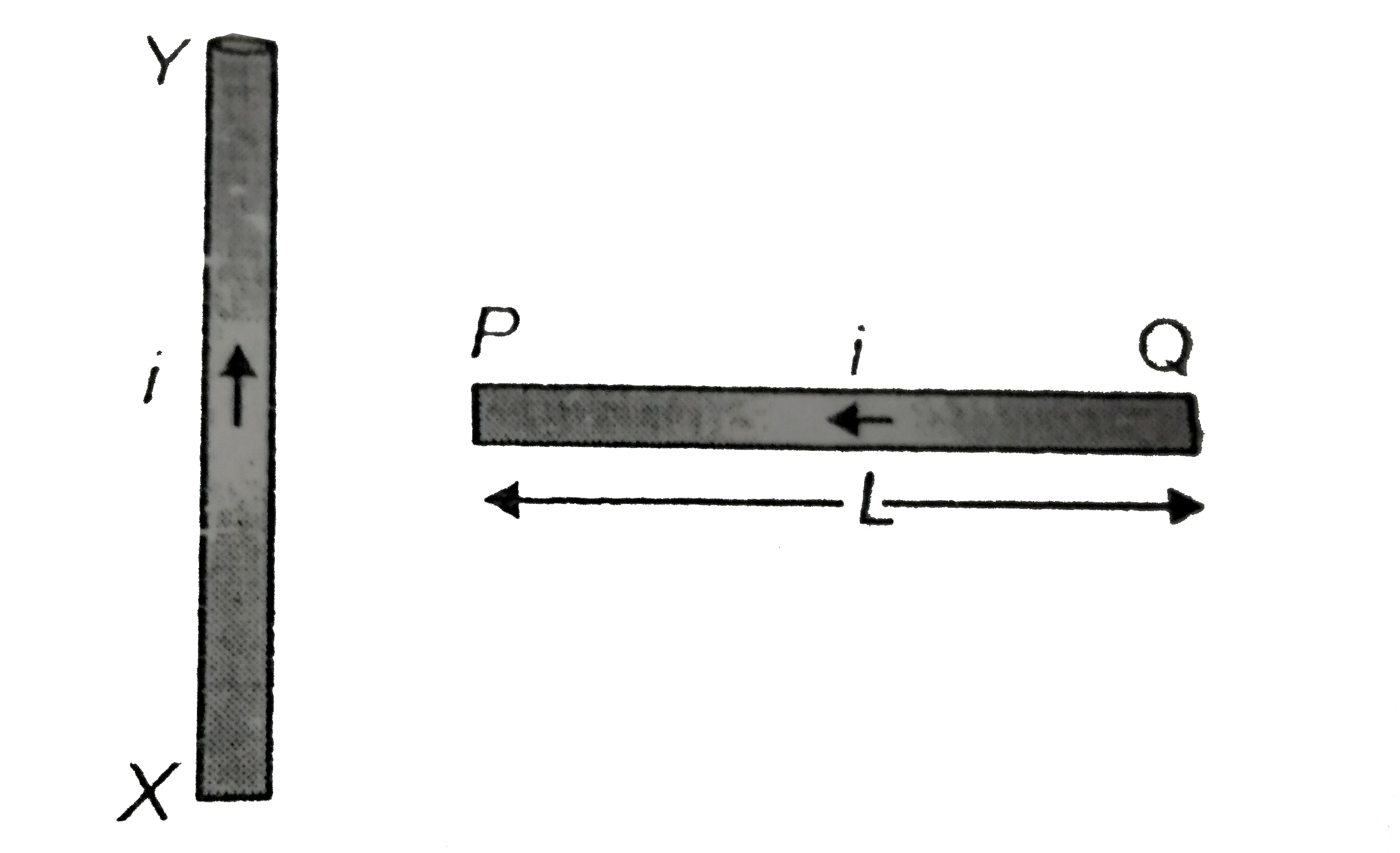A long conductor carrying a current of is perpendicular to a magentic field of . The mechanical power to move the conductor with a speed of is
The correct Answer is:C
To solve the problem, we need to calculate the mechanical power required to move a conductor in a magnetic field. Here's the step-by-step solution:
Step 1: Identify the given values
- Length of the conductor (L) = 0.1 m
- Current (I) = 50 A
- Magnetic field strength (B) = 1.25 mT = 1.25 × 10^(-3) T (since 1 mT = 10^(-3) T)
- Speed of the conductor (v) = 1 m/s
Step 2: Calculate the magnetic force (F) on the conductor
The magnetic force experienced by a current-carrying conductor in a magnetic field is given by the formula:
F=I⋅L⋅B
Since the conductor is perpendicular to the magnetic field, we can use the formula directly without the sine term.
Substituting the values:
F=50A⋅0.1m⋅(1.25×10−3T)
F=50⋅0.1⋅1.25×10−3
F=6.25×10−3N
Step 3: Calculate the mechanical power (P)
The mechanical power required to move the conductor at a constant speed in the magnetic field can be calculated using the formula:
P=F⋅v
Since the force is in the direction of the velocity, we can use the formula directly.
Substituting the values:
P=(6.25×10−3N)⋅(1m/s)
P=6.25×10−3W
Step 4: Convert power to milliwatts
To express the power in milliwatts:
P=6.25×10−3W=6.25mW
Final Answer
The mechanical power required to move the conductor is 6.25 mW.
---
- Length of the conductor (L) = 0.1 m
- Current (I) = 50 A
- Magnetic field strength (B) = 1.25 mT = 1.25 × 10^(-3) T (since 1 mT = 10^(-3) T)
- Speed of the conductor (v) = 1 m/s
The magnetic force experienced by a current-carrying conductor in a magnetic field is given by the formula:
F=I⋅L⋅B
Since the conductor is perpendicular to the magnetic field, we can use the formula directly without the sine term.
F=50A⋅0.1m⋅(1.25×10−3T)
F=50⋅0.1⋅1.25×10−3
F=6.25×10−3N
The mechanical power required to move the conductor at a constant speed in the magnetic field can be calculated using the formula:
P=F⋅v
Since the force is in the direction of the velocity, we can use the formula directly.
P=(6.25×10−3N)⋅(1m/s)
P=6.25×10−3W
To express the power in milliwatts:
P=6.25×10−3W=6.25mW
The mechanical power required to move the conductor is 6.25 mW.
Topper's Solved these Questions
- BOOK - DC PANDEY ENGLISHCHAPTER - ELECTROMAGNETIC INDUCTIONEXERCISE - Taking it together119videos
ELECTROMAGNETIC INDUCTION
- BOOK - DC PANDEY ENGLISHCHAPTER - ELECTROMAGNETIC INDUCTIONEXERCISE - Medical entrance special format questions17videos
ELECTROMAGNETIC INDUCTION
- BOOK - DC PANDEY ENGLISHCHAPTER - ELECTROMAGNETIC INDUCTIONEXERCISE - Example71videos
ELECTROMAGNETIC INDUCTION
- BOOK - DC PANDEY ENGLISHCHAPTER - CURRENT ELECTRICITYEXERCISE - Medical entrances gallery97videos
CURRENT ELECTRICITY
- BOOK - DC PANDEY ENGLISHCHAPTER - ELECTROMAGNETIC WAVESEXERCISE - Sec C22videos
ELECTROMAGNETIC WAVES
Similar Questions
A conductor PQ, carrying a current i is placed perpendicular to a long conductor xy carrying a current i. The direction of force on PQ will be
 View Solution
View SolutionA straight conductor of length 0.4 m is moved with a speed of 7 m/s perpendicular to the magnetic field of intensity of 0.9Wb/m2. The induced e.m.f. across the conductor will be
View SolutionThe figure shows a conductor of weight 1.0N& length L=0.5m placed on a rough inclined plane making an angle 30∘ with the horizontal so that conductor is perpendicular to a uniform horizontal magnetic field of induction B=0.10T.The coefficient of static friction betwen the conductor inside the plane of is 0.1. A current of l=10A flows through the conductor inside the plane of this paper as shown.What is the force needed to be applied parallel to the inclined plane to keep the conductor at rest?
 View Solution
View SolutionA circular loop of area 1cm2 , carrying a current of 10 A , is placed in a magnetic field of 0.1 T perpendicular to the plane of the loop. The torque on the loop due to the magnetic field is
View SolutionA conductor in the form of a right angle ABC with AB=3cm and BC=4cm carries a current of 10A.There is a uniform magnetic field of 5T perpendicular to the palne of the conductor. The force on the conductor will be
View SolutionA conductor in the form of a right angle ABC with AB=3cm and BC=4cm carries a current of 10A.There is a uniform magnetic field of 5T perpendicular to the palne of the conductor. The force on the conductor will be
View SolutionA straight conductor of weight 1 N and length 0.5 m, is located in a plane making an angle 30∘ with the horizontal so that it is perpendicular to a uniform mangetic field of induction B=0.109T. Given that the conductor carries a current of 10 A away from the reader, and coefficient of static friction is 0.1, find the force needed to be applied parallel to the plane to sustain the conductor at rest.
View SolutionCapacitance (in F) of a spherical conductor with radius 1m is
View SolutionConsider two parallel conducting frictionless tracks kept in a gravity-free space as shown in Fig. 3.200. A movable conducting PQ, initially kept at OA, is given a velocity 10ms−1 toward right. The space contains a magnetic field which depends upon the distance moved by conductor PQ from the OA line and given by

→B=cx(−ˆk)[c=constant=1SIunit]
The mass of the conductor PQ is 1kg and length of PQ is 1m. Answer the following question based on the passage.
The distance travelled by the conductor when its speed is 5ms−1 isView SolutionA copper rod of length 0.19m is moving with uniform velocity 10ms−1 parallel to a long straight wire carrying a current of 5.0A. The rod is perpendicular to the wire with its ends at distances 0.01 and 0.2m from it. Calculate the emf induced in the rod.
View Solution

